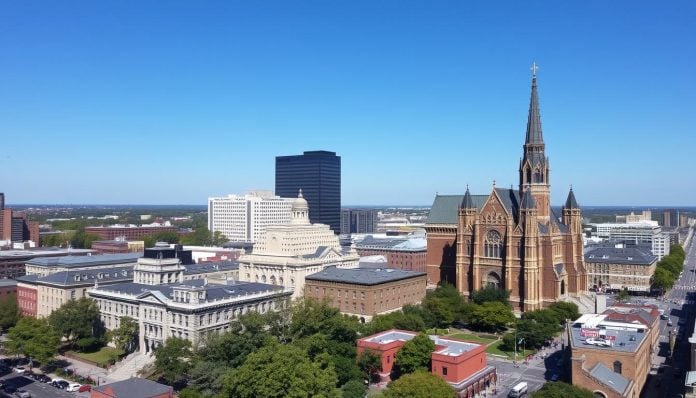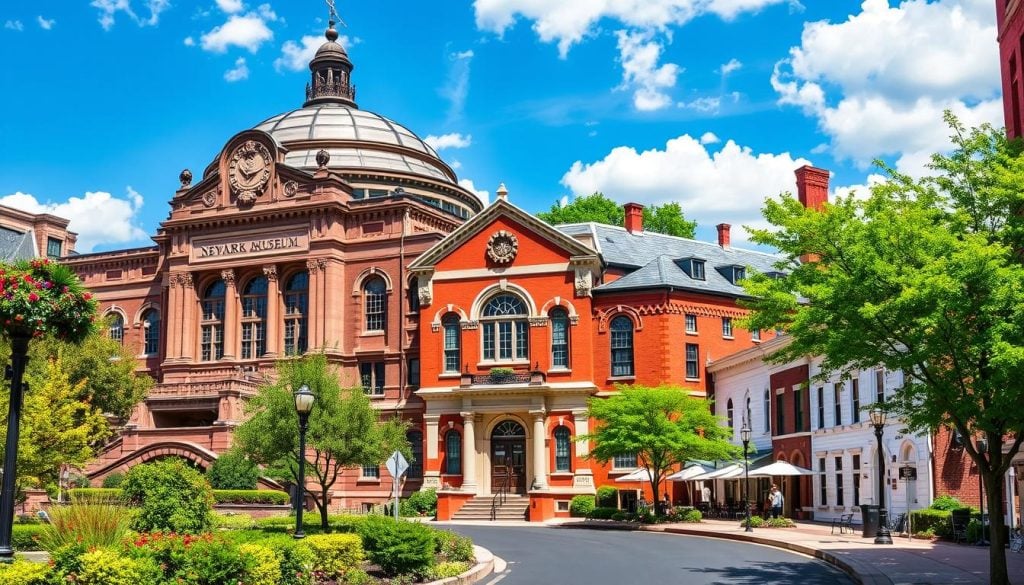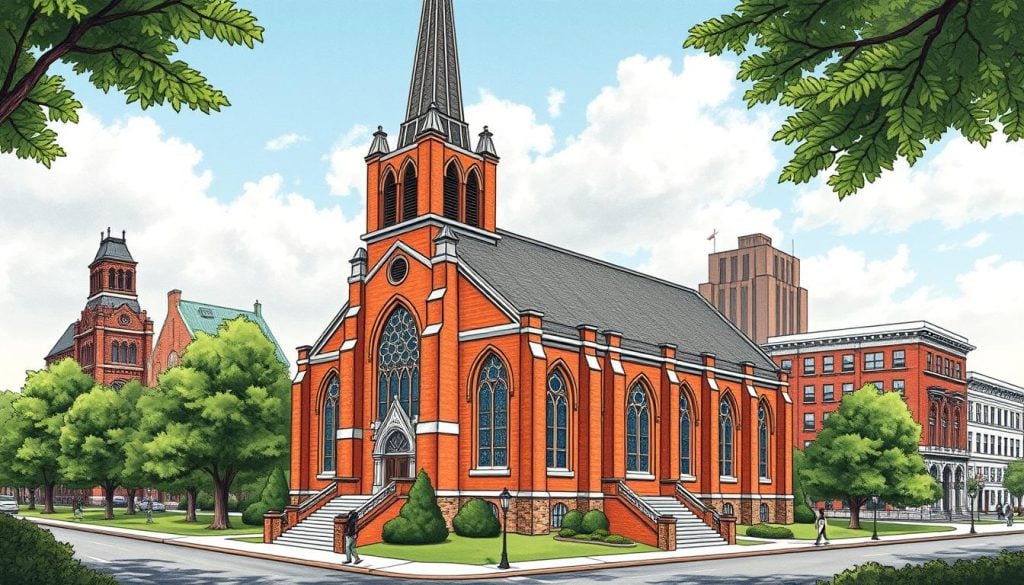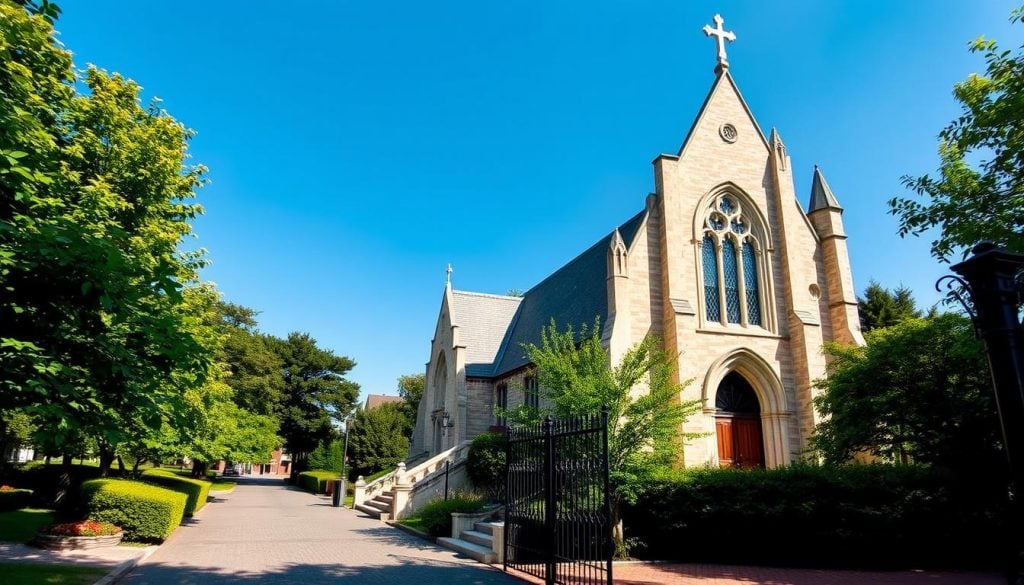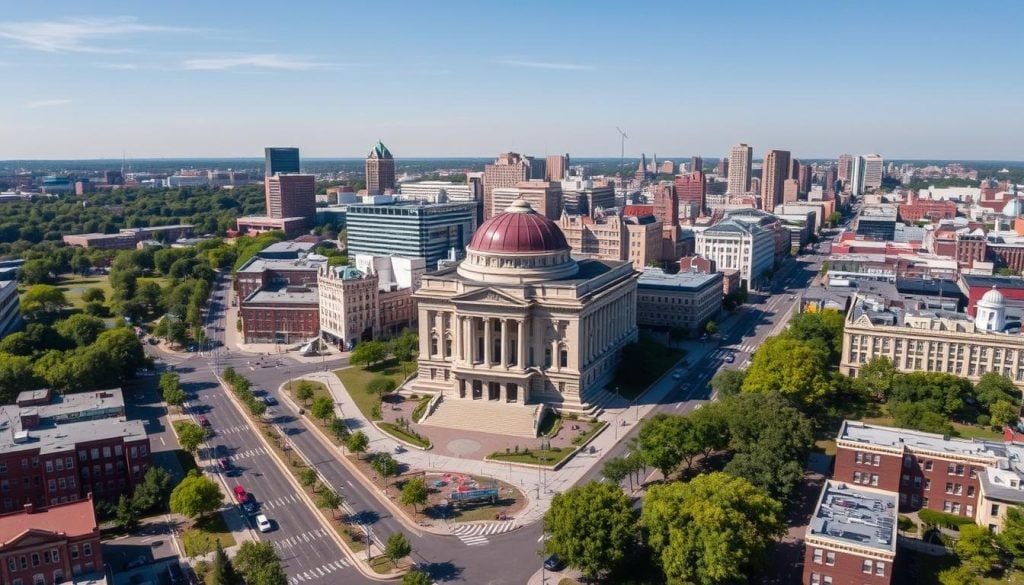Have you ever wondered what secrets lie in Newark’s streets? This city, founded in 1666, is full of stories that change how we see American history. Let’s explore Newark’s past through its historical landmarks. Each one tells a story of a vibrant culture and rich heritage.
Are you curious about the top historical sites in Newark? Or maybe you want to find the best places to see in Newark? This guide will show you the important sites that make Newark what it is today.
Introduction to Newark’s Rich History
Newark’s history is full of different cultures and key events. As you look into Newark’s past, you’ll see how it changed from a Puritan settlement to a busy industrial center in the 19th century. Each stage of its growth has made Newark what it is today, with many historical places that tell interesting stories.
These landmarks show how the city changed. By visiting these places, you learn about Newark’s evolution. You’ll see how old traditions and new ideas mix in the city today. Exploring historical tours is a great way to deepen your knowledge of Newark’s important spots.
The Significance of Historical Preservation in Newark
Keeping Newark’s historic spots safe is key to keeping the city’s rich culture alive. Efforts to preserve history protect buildings that share Newark’s story. These places connect us to the past and the traditions that shaped our community.
When historical sites are cared for, they boost community pride. Groups focused on saving history lead restoration and learning projects. These efforts show why keeping history alive matters and bring people closer together.
Going on Newark historical tours helps you see why saving these places is important. Tours show how the city’s history still shapes today’s culture. By joining these tours, you help keep Newark’s heritage vibrant.
What are the must-visit historical sites in Newark?
Newark is full of historical sites that tell its story. These landmarks are key for anyone wanting to explore the city’s history. Each spot has its own story, showing the growth of culture, society, and architecture.
Explore the Historical Depth of Newark
Walking through Newark, you’ll see sites that show the city’s history. The Essex County Courthouse and the Old First Presbyterian Church are just a few. They are not just beautiful but also tell stories of Newark’s past.
Reasons to Visit Each Site
- Essex County Courthouse: Showcases stunning architecture and plays a pivotal role in the legal history of Newark.
- Old First Presbyterian Church: A beacon of faith that highlights the community’s religious heritage.
- Newark Symphony Hall: A cultural arena that has hosted countless performances, anchoring the arts in Newark.
Visiting these sites gives you a deeper look at Newark’s identity. You’ll see beautiful architecture and hear stories that made Newark what it is today.
| Site | Historical Significance | Architectural Style |
|---|---|---|
| Essex County Courthouse | Key legal proceedings and historical events | Romanesque Revival |
| Old First Presbyterian Church | Foundation of community faith and culture | Gothic Revival |
| Newark Symphony Hall | Cultural performances and community involvement | Art Deco |
Iconic Landmark: Essex County Courthouse
The Essex County Courthouse is a key landmark in Newark, known for its historical architecture. It was built in 1904 and shows off Renaissance design. This makes it a symbol of elegance and civic pride.
A Closer Look at Its Architecture
People love the Courthouse for its beautiful marble columns and detailed decorations. Its glass-domed roof lets in natural light, making the inside look even more impressive. The care put into building it shows Newark’s architectural skill.
The Courthouse’s Role in Newark’s History
This courthouse is not just a place for trials. It also marks important moments in Newark’s history. Being on the National Register of Historic Places shows its big impact. It’s a key spot for those wanting to see Newark’s history and beauty.
Religious Significance: Old First Presbyterian Church
The Old First Presbyterian Church is a key part of Newark’s religious history. It was founded in 1667 and has seen many changes over the years. It keeps its historical value while meeting the needs of its community. This church is a key spot for both spiritual and social events in Newark.
A Historical Timeline of the Church
The story of the Old First Presbyterian Church is filled with important events:
- 1667: The church was started, shining a light for early worship in Newark.
- 1788: A new building was built because the old one couldn’t hold the growing number of people.
- 1878: The church we see today was finished, showing off its stunning design.
- 1984: It was named a historic site, showing its big role in Newark’s culture.
- Present: The church is still alive and active, hosting events and services for the community.
Cultural Events and Their Impact
The church is more than just a place for worship. It plays a big part in the community through cultural events. These events include:
- Annual concerts with local artists
- Community service projects
- Holiday events that bring people together
These activities help build stronger community bonds and bring different groups together. The Old First Presbyterian Church shows how religious places can boost cultural and social unity.
Newark City Hall: A Government Icon
When you visit Newark, you’ll see how important its government buildings are. Newark City Hall, built in 1902, is a key example of the era’s architectural beauty. It’s more than just a place for work; it’s a symbol of Newark’s politics and history.
Architectural Features of Beaux-Arts Style
Newark City Hall’s Beaux-Arts style is known for its classical elements. You’ll see grand staircases and detailed work. This style aims to impress with:
- Grand entryways that welcome visitors into large halls
- Ornamental sculptures on the outside
- Exquisite moldings and decorations inside
These features show the city’s artistic and historic commitment. The building’s beauty makes it a key landmark in Newark. It’s a spot you shouldn’t miss when you’re there.
Grace Church: The Episcopal Sanctuary of Newark
Grace Church is a key spot in Newark, mixing spiritual importance with stunning architecture. It started in the 1830s and is now a big part of Newark’s history. It helps both its members and the wider community.
The Church’s Historical Contributions to the Community
The design of Grace Church shows off the Gothic Revival style, with its detailed work. It has been a place for many community events over the years. This makes it a key social spot in Newark.
Visiting this place shows its role goes beyond just worship. It supports cultural events and outreach, bringing people together. Grace Church is a top spot among Newark’s historical sites, showing the past and present.
The church’s historic organ and beautiful interiors grab your attention. They remind us of its deep history. Grace Church stands out in Newark for its mix of faith and culture. It shows how these things make the community richer, capturing the essence of Newark.
Cultural Hub: Newark Symphony Hall
Newark Symphony Hall is a key spot in Newark’s cultural scene. It has been a hub for the arts since 1925. The hall is known for its diverse performances, drawing in people from all walks of life.
Highlights of the Performances
At Newark Symphony Hall, the shows are the heart of its cultural vibe. You’ll see everything from famous orchestras to local talent. The hall offers:
- Classical concerts by top orchestras
- Jazz nights with local stars
- Theater shows that leave you amazed
- Community events that highlight local talent
Importance to Newark’s Cultural Scene
Newark Symphony Hall is crucial to the city’s cultural identity. It’s more than just a place for shows; it’s where the community comes together. By hosting a variety of events, the hall boosts Newark’s artistic scene.
It supports local artists and gives a voice to cultural expression. This makes it a top spot for music and performance in Newark.
Historic Architecture: The Feigenspan Mansion
The Feigenspan Mansion is a key piece of Newark’s architectural scene. Built in 1901, it shows off American Renaissance architecture. This historic home in Newark is known for its beauty and tells the story of the city’s wealthy industrial leaders.
The mansion’s detailed designs and rich interiors take you back to a time when Newark was booming industrially. It’s a peek into a past era of grandeur.
Understanding American Renaissance Architecture
The American Renaissance movement shaped the Feigenspan Mansion’s look. It’s all about grandeur, historical touches, and fine craftsmanship. This style mixes classic elements with new designs, showing the unique architecture of early 20th-century America.
Learning about this style helps you see how it mirrors Newark’s cultural and economic changes back then.
Significance of Its Historical Context
The Feigenspan Mansion’s history adds to its architectural importance. It shows off the wealth of Newark’s early industrialists and the city’s growth during the industrial revolution. Its preserved beauty reminds us of Newark’s deep history, making it a must-see for history buffs.

































